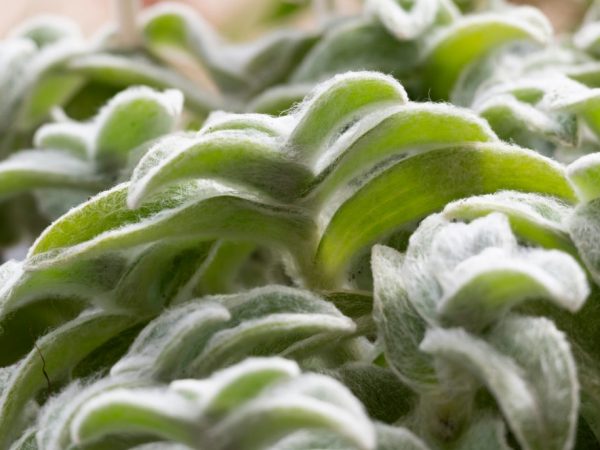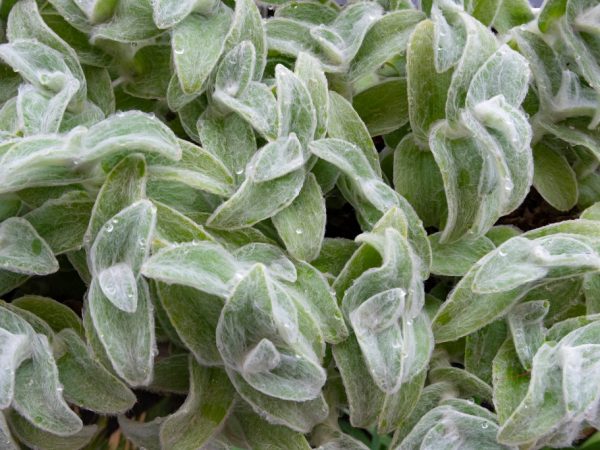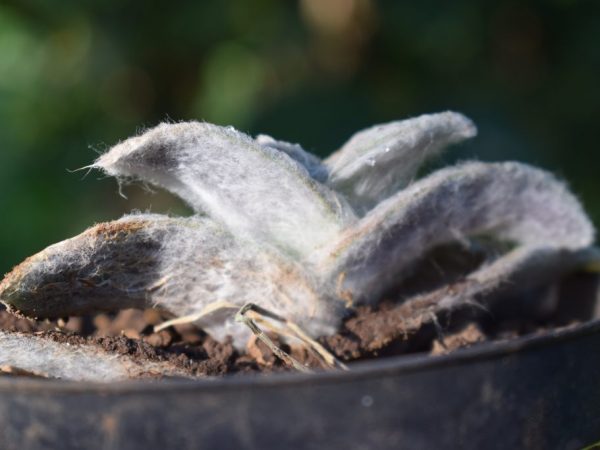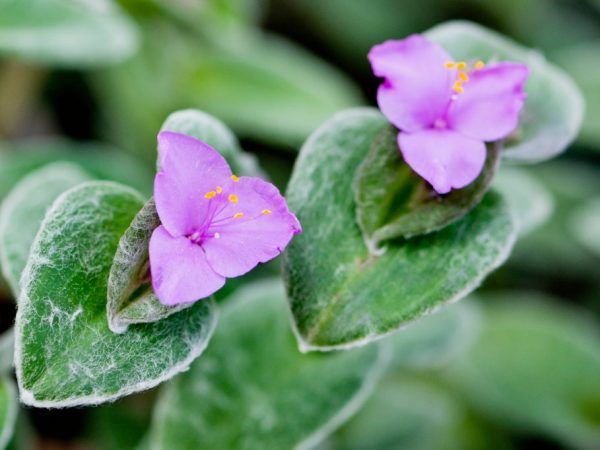Tradescantia Sillamontana - how to grow at home
Tradescantia Sillamontana got its name from the place of growth - the vicinity of a mountain located in the southeast of Mexico, the state of Nuevo Leon. Differs in simplicity, good coexistence with other plants, the ability to purify the air. Fans of ornamental crops often pay attention to this perennial evergreen deciduous flower.

Tradescantia Sillamontana - how to grow at home
Description of the plant
In an open area, a perennial grows up to 30-40 cm.When grown indoors, in a container, it has a height of up to 20 cm.Its width can reach 50 cm.
The root system is superficial and grows rapidly. Represents dense, thick, fibrous, finger-like branches.
Young shoots are erect, with maturation they begin to creep, take root on the soil surface. The color of the stems is purplish green.
Foliage is variegated, variegated, fleshy structure. Oval shape, pointed tips. Length - from 3 to 7 cm. Fastening alternate, sedentary. The color of the upper part is olive, with a silvery sheen, in bright light it looks red-violet, the lower part has a violet-purple hue.
Inflorescences form in the axils of the cover sheets, at the apical points of growth. Most often they are single, occasionally there are paired ones. Corollas have 3 purple petals, up to 3 cm in diameter.
The fruit is a folding box with 2 or more seeds.
Bloom
The flowering period is in July and lasts about a month (possibly also in spring). With proper cultivation, with timely feeding, location in a place provided with a sufficient amount of light and heat.
The inflorescence blooms for 1 day, then withers, giving way to a new flower.
This is interesting: the leaves and stems of Tradescantia sillamontana are covered with white hairs that resemble a cobweb or felt. They protect against sunburn and excessive moisture evaporation. The pubescence gave the flower a second name: White Velvet.
Purchase and adaptation
When buying a plant, inspect it carefully. You should refrain from buying if:
- there is no characteristic spider-like pubescence;
- the color of the leaf plates is pale, not bright;
- the leaves have dark spots, dry areas.
After purchasing Tradescantia, you must go through an adaptation period. Its duration is about 2 weeks. At this time, the culture is not transplanted or fertilized.
Landing rules
For planting, choose a wide, not very high clay or ceramic container. It is desirable that there is no decorative coating on it, and the walls have good air permeability.
Drainage material is placed on the bottom:
- Styrofoam;
- medium-sized pebbles;
- expanded clay.
This will protect the flower from moisture stagnation, leading to the development of a fungus on the roots - fungal rot.
Important: if Tradescantia is planted in a plastic pot, it is necessary to regularly loosen the soil to avoid a lack of oxygen in the root system.
Growing conditions
Selection of soil and location

The flower doesn't like shadow
The windows facing south, southwest, southeast are best suited. The place should not be too shaded, otherwise the culture will lose its decorative effect.
In the summer, you can take the flower outside, while avoiding direct sunlight and drafts.
The soil must be nutritious and have:
- acidity in the range from 6 to 7.3 pH;
- a high degree of friability;
- drainage component.
The drainage component should account for from 1/3 to half of the volume of the entire soil. Coarse river sand, gravel is well suited.
You can purchase a ready-made substrate for succulents or make it yourself by taking peat, sod land, deciduous humus, river sand of a coarse fraction in a ratio of 1: 2: 2: 1.
Tip: If you've prepared soil, freeze it in the freezer, then steam it in the oven. This will destroy harmful microorganisms in it.
Humidity
Optimum humidity is 35% or more. In winter, this level will be supported by:
- a container with water installed next to the flower;
- climatic device - air humidifier.
- Excessive dryness can provoke the appearance of harmful insects - spider mites.
Temperature
The plant thrives best in warm temperate climates. In summer, the preferred temperature is from +18 to 25ºC.
In winter, in the resting phase, it should not fall below + 10ºC. This indicator is the least tolerable for the culture.
Lighting
It is a light-loving plant that needs good illumination. The recommended duration of daylight hours is at least 8 hours. However, do not leave the flower in direct sunlight, as this can burn the leaves.
You need to gradually accustom Tradescantia to the sun. For example, put it under its rays for a short time twice a day: in the morning and in the evening.
Lack of lighting leads to stretching of the stems, loss of decorative appearance.
Home care
In order for a plant grown at home to please with its healthy and beautiful appearance, it needs competent care: selection of the right soil, location, application on time and in the right amount of fertilizers, provision of optimal humidity, temperature, lighting.
Watering should not be excessive or insufficient, the transplant should be carried out in a timely manner.
Fertilizers and feeding

The plant is fertilized during the flowering period
Tradescantia is fertilized with complex liquid fertilizers with mineral components for succulents and decorative deciduous crops. Application frequency:
- during the active growing season (March-November) - once every 14 days;
- at rest (winter months) - the culture is not fertilized.
In the case of a flower transplant, dry top dressing of long duration is added to a new pot.
Recommendation: Do not exceed the amount of nitrogen. Its overabundance in the soil provokes a loss of decorativeness: the plant almost completely turns green.
Watering
The plant belongs to xerophytes, it easily withstands a short-term moisture deficit without losing its decorative features. Watering frequency depends on:
- season of the year;
- ambient temperature;
- humidity.
In the summer, the flower is watered 3 times a week, often sprayed. In winter, watering is reduced to 1 time in 7 to 10 days. The number of sprays is also reduced.
Optimum is the moisture of the soil as it dries up by 2 cm. Drying tips of the leaves will indicate the lack of moisture. If they appear, the frequency of watering is increased.
Tip: Water Tradescantia Sillamontana with rainwater. Drain the excess accumulated in the pallet.
Transfer
The transplant is carried out in the spring. Young flowers are replanted annually to provide the space needed for root growth. An adult culture is moved into a pot 1.5 - 3 cm larger in size once every 3 years, after the root system has mastered the earthen lump.
Step-by-step actions:
- moisten the soil abundantly;
- put a drainage layer and 1/3 of the volume of the substrate on the bottom;
- remove the plant along with the earthy clod;
- gently shake off the top layer;
- place the sillamontana in a new pot, placing the root collar about 3 cm below the edge of the container;
- Fill the free space with the substrate to the top.
- After transplanting, the flower is not watered for 2 days.
Reproduction methods
Sillamontana is propagated in several ways: by seeds, cuttings, dividing an adult plant.
Seeds
Labor-intensive way. Among the disadvantages - the flowering stage is reached only after 3-4 years.

It is difficult to propagate Tradescantia by seeds
Stages:
- pre-soak the seeds in a growth stimulator;
- sow the soil with them, deepening by 1 cm;
- water the landing;
- cover the container with glass or polyethylene to create a greenhouse effect;
- put in a shaded place.
Until sprouts appear, the sowing is opened every day for airing and watered. After germination, the cover is removed, the greenhouse is transferred to a lighted place.
Cuttings
In this way, Tradescantia can be propagated year-round, although root formation will be slower in winter. Separate young shoots 5 to 8 cm long from parent plants during pruning or pinching, then:
- pour water into a jar (1 l) for a little more than half of the volume;
- put expanded clay on the bottom, a mixture of peat with coarse sand or 3 pieces of coal with a diameter of 2 cm;
- cover the jar with baking foil, tying it around the neck with thread or securing it with an elastic band;
- make 2 cm holes in the foil according to the number of cuttings;
- insert shoots into the holes.
Rooted shoots are transplanted into pots after about 1-1.5 months.
Recommendation: for the quickest appearance of roots, try to keep the room temperature +16 ºC.
By dividing an adult bush
The fastest and most efficient way. Take an overgrown Tradescantia with a strong root system. The procedure is carried out in the spring.
The plant is removed from the pot, the soil is removed from the roots, and divided into parts. The separated shoots are planted in separate containers with soil. Further, the flowers are looked after as for adult sillamontans.
Diseases and pests
Tradescantia is able to withstand many plant diseases, but sometimes it is still attacked by pests and diseases:
| Diseases, pests | Control methods |
| Root rot | Only plants infected with rot by no more than 1/3 part can be cured. The affected areas are cut off, clean roots are impregnated with a weak solution of potassium permanganate (potassium permanganate), treated with fungicides, for example, Fitosporin. The soil is replaced with a new substrate. |
| Too long stems, a decrease in the number of leaves, their acquisition of a monochromatic green color. | The reason is the lack of light. It is necessary to rearrange the flower on the sunny side, arrange artificial illumination with fluorescent lamps. |
| The appearance of a brown border on foliage | The reason is a lack of moisture, an excess of light. The plant is transplanted to a darker place, the number of waterings is increased. |
| Yellowing of leaves | Insufficient air humidity. It is necessary to increase the humidity indicator in the room. |
| Bare stems at the base | Talking about the old age of the plant. Transplantation is necessary using the cuttings method. |
| The flower stops blooming, loses its variegation | Indicates an excess of nitrogen. It is necessary to reduce the dosage of fertilizer. |
| Pests: scale insect, aphid, whitefly, spider mite, mealybug | The appearance of small bugs, brown spots on the leaves, wilting of the stems and leaves speaks of the damage to the flower by pests.Ways of struggle: rubbing with soapy water (take 50 g of soap for 1 liter of water), alcohol or garlic pulp diluted with water. If the lesion is massive, Tradescantia is treated with insecticides: karbofos, actellik, actara, fufanon, etc. |
Healing properties
Tradescantia has a number of medicinal properties, it is often used in alternative medicine. It helps well in wound healing, normalizes digestion processes.
The Sillamontana variety is easy enough to grow at home because of its simplicity, good coexistence with other plants. And the original appearance of a flower with "felt" leaves will delight the eye of any grower.


